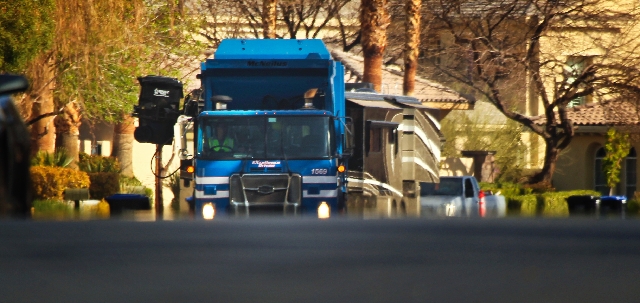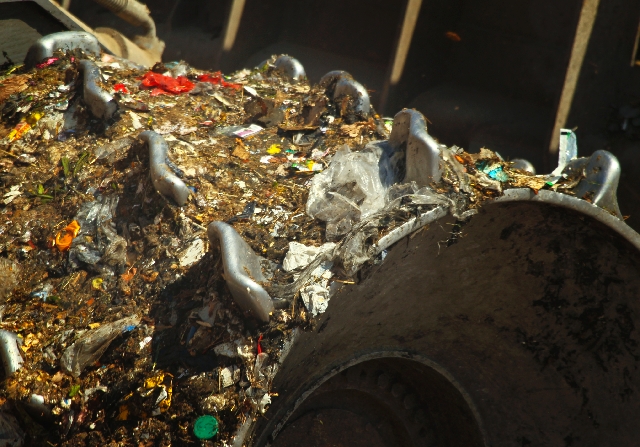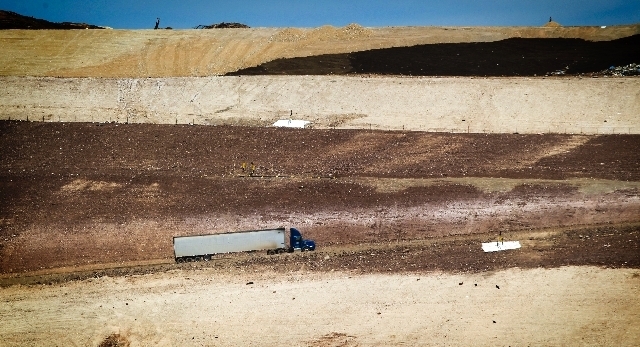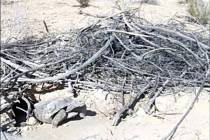Apex landfill: There’s no place like home for Las Vegas garbage






It’s Nevada’s biggest ongoing construction project, and you help build it every day.
Each rotten apple, spork, pizza box and Styrofoam cup you throw out is a brick in the $300 million pyramid of trash at Las Vegas’ Apex landfill. The site averages nearly 300 tons of garbage every hour, enough to make it the nation’s largest in tonnage received. What’s more, the 20-year-old landfill has a projected life of 250 years, which means your great-great-great-great-great-great-great-great-great-grandchildren will build on the foundation you lay today.
NATION’S BIGGEST
If you’re like most people, you don’t think much about trash. But here’s the least you should know: If yours is an average local household, each week you toss out 58 pounds — equal to the weight of an average 7-year-old.
“It’s a strange dynamic to have things that are ours, and we put them on a curb, and they suddenly become someone else’s responsibility,” said John Campanelli, editor of Waste & Recycling News, a trade publication. “When we throw things out, we abdicate our responsibility in a lot of ways. We pass it to people and places that are invisible to us. Things are manufactured and consumed and discarded. It’s kind of a big story of our society that is so widely ignored.”
It would be a shame to ignore this story. Like a lot of things that happen in Las Vegas, the tale of trash is more interesting than it is in other places. Apex isn’t just the nation’s biggest landfill. It’s also one of the first designed under environmental regulations that took effect in the early 1990s. It is in the vanguard of industry change. History in the making. Evolution that is far from complete.
To understand the role you play in shaping Apex and its future, we’ll follow the trash from one household to its resting place.
TRASH PICKUP DAY
Our trash begins its journey on a March morning at Red Rock Country Club, where retired executive secretary Marilee Doyle has finished her protein shake and is tying up bags of garbage. It’s Thursday — trash pickup day — and Doyle has pulled expired food from the fridge and emptied wastebaskets from around her house.
As she wheels her 96-gallon toter to the curb, Republic Services driver Jerry Baits wends his way up the street, stopping at each house. He never leaves his truck. A mechanical arm pops out of the top, swings down, hugs the can, pulls it up and tips it into the waste collector.
Baits will fill his truck twice today, emptying cans at 1,270 homes. By the end of his 10-hour shift, Baits will have collected 20 tons of trash, equal to 1.28 million empty yogurt cups, 426,667 banana peels or 100,000 empty soy sauce bottles.
Baits has driven for Republic for 20 years, and the automatic truck makes the job much less strenuous than it used to be.
Baits will log 8,200 miles in 2013, the equivalent of driving south to north across Nevada and back eight times. He drives one of Republic’s newer trucks, which runs on compressed natural gas.
About a quarter of Republic’s 200-truck residential fleet is CNG-powered. The company plans to replace all diesel trucks within five years to cut greenhouse-gas emissions and to boost driver safety, said Bob Coyle, Republic’s vice president.
Baits’ truck is full soon after he empties Doyle’s trash. He leaves Red Rock and hops onto the Las Vegas Beltway for the 20-minute drive to Republic’s Cheyenne transfer station, on Cheyenne Avenue west of Interstate 15. The station is the busiest of Republic’s two local transfer depots, handling 5,000 tons a day — about the same weight as 64 million large, Grade A eggs, or 160 million empty Girl Scout cookie boxes.
About 70 percent of Apex’s 7,000-ton daily volume for 2013 will pass through this station. The rest goes through the Henderson location near Sunset and Gibson roads.
Baits guides his truck up a ramp, backs up to a sheltered open pit where as many as six trucks can unload at a time, and drops Doyle’s trash, and everything else.
After Baits drives away, a bulldozer in the pit’s bottom attacks his truck’s load, pushing Doyle’s bags toward an underground alley where semitrailer transfer trucks line up. The dozer shifts up to 30 tons — three collection truck loads — into each transfer truck. Each truck is weighed and its load is covered with a tarp before the trip 15 miles up I-15 to Apex.
The process is quick and efficient. The garbage Marilee Doyle put at the curb after breakfast will reach the landfill before she eats lunch.
ISOLATED LANDFILL
Doyle’s garbage is destined for what Campanelli calls the “perfect” landfill.
Unlike landfills in other cities, which are often near populated areas, Apex is tucked in the valley of an isolated mountain range 20 miles north of town and about a mile east of I-15. It is surrounded by public land and industrial plants, far enough from any houses that no one ever smells it, but close enough to be economical for Republic. With little annual rain and a 500-foot-thick buffer of packed rock and earth between waste and water table, runoff contamination isn’t an issue.
“This is how facilities should be permitted,” Apex General Manager Mark Clinker said.
Apex is the largest of the Phoenix-based company’s 193 sites. Republic doesn’t disclose earnings by landfill, but the company did $8.12 billion in revenue in 2012, or more than 16 percent of the nation’s $50 billion-a-year waste-management industry.
Apex is widely regarded as the nation’s biggest landfill by weight. Both Forbes and Waste & Recycling News ranked it No. 1 in 2010, when it took in 3.34 million tons, or about 9,000 tons a day. That was 1.3 percent of the country’s 249.9 million-ton total, and more than a million tons ahead of No. 2, an Indiana landfill southeast of Chicago.
Apex has kept a frenetic pace since it opened in October 1993, the same month Luxor and Treasure Island debuted. It holds 59 million tons of garbage, perhaps including set lists from Frank Sinatra’s last Vegas show in May 1994 at the MGM Grand Theater, as well as food-and-beverage waste from the Sands Hotel’s final hurrah in June 1996, and demolition detritus from the Hacienda, imploded on New Year’s Eve 1996. The site’s 20 years’ worth of refuse runs nearly 300 feet deep, about the same height as the Wells Fargo tower on Paradise Road. Its footprint is 300 acres, the size of a 2,000-home subdivision.
That’s nothing compared to what Apex could be. At its projected build-out around 2263 — the same time Capt. James T. Kirk takes over the starship USS Enterprise — it will have grown to more than 1,200 acres, on a total site of 2,200 acres. That’s the same size as New York’s Fresh Kills, the granddaddy of all U.S. landfills by footprint, visible from the moon.
To date, it has taken $300 million to $500 million to build Apex, Coyle estimated. That’s about what SBE Entertainment is spending to remake the Sahara as SLS Las Vegas.
It’s unusual for a metro area of just 2 million to have such a massive landfill. But it’s also unusual for a city this size to have only one waste site and no incinerators, Campanelli said. That, more than the city’s 40 million visitors, explains why Apex collects so much.
Clinker agreed that tourists don’t contribute as much as you might think to Apex. Hotels recycle much more than households do. MGM Resorts International, for example, recycles or reuses more than 90 percent of waste from trade shows at its Mandalay Bay Convention Center. Caesars Entertainment Corp. will divert more than a third of its waste from the landfill by 2014 by training all event and banquet managers in waste reduction and sanitizing and sending unused shampoo and other hygiene products to needy communities.
What garbage the resorts do produce is collected overnight because it’s hard to disturb anyone’s sleep around the Strip. Everything making the trip with Doyle’s garbage came from locals.
TRANSFER TRUCKS
Transfer truck driver Emiliano Izquierdo is carrying Doyle’s garbage bags from Cheyenne to Apex in one of six or seven loads he moves daily. The transfer trucks belong to Illinois-based contractor KR Drenth, which has more than 30 in Southern Nevada.
A loaded KRD truck enters Apex an average of every five minutes around the clock. During the landfill’s busiest hours, from 9 a.m. to 4 p.m., that number jumps to 20 trucks an hour, and 600 tons of garbage — about as much as 4.8 million back issues of Time magazine.
Izquierdo stops at the landfill’s front gate to weigh his load, then trundles up a dirt road, past a Las Vegas Paving plant. After 1½ miles, Izquierdo reaches the landfill’s 3-acre open face. He backs up to one of three semitrailer tippers, disconnects the trailer from his truck, attaches it to the tipper and presses a button. The hydraulic tipper eases the front of the trailer into the air. Trash, including Doyle’s bags, trickles, then gushes out, cascading into a sea of buckets, plastic grocery bags, milk crates, yard waste, canvas kids’ shoes, aluminum cans, utility bills, fast food containers, tires, blankets, detergent bottles, phone books and carpet padding.
It takes less than a minute for Izquierdo’s trailer to empty.
As Izquierdo lowers the trailer-tipper and reconnects the trailer to his truck for his next pickup, a 60-ton Caterpillar trash compactor moves in to shovel and roll over the freshly dumped trash, shredding and crushing Doyle’s bags and their contents. The compactor’s 5-foot metal wheels each have 28 cleats to grind and compress the garbage, maximizing landfill capacity.
Apex has five compactors, with two or three running at all times.
Longtime landfill workers insist they don’t notice the smell, but at the open face a million Odor Eater insoles couldn’t touch the stench — and that’s before the sewage-sludge truck arrives. Waste from the city’s four treatment plants comes here, 20 tons per truck, up to 40 times a day. It’s the one part of the landfill where tourist traffic shows.
“In a good weekend, that volume goes up,” Clinker said.
The sludge mixes with other organic materials — mostly food waste and lawn cuttings — to help decomposition inside the landfill.
Because much of her garbage is expired food products, Doyle’s trash will start decomposing in a few days. It will be buried by another 10 days’ or so of trash, and then covered with an 18-inch dirt layer. Over the next 15 years the dirt may be removed, and Doyle’s bags could be buried by as much as 150 more feet of refuse. But for now, the landfill is crawling due east. A month after Doyle’s garbage reached its final resting spot the landfill had advanced 150 feet.
But we’re not quite done with Marilee Doyle’s trash.
First, a little background: From 1976 to 1984, the federal government passed new laws related to landfill operation. Any landfills built after the early ’90s had to be lined with heavy plastic to prevent groundwater contamination, and they would have to contain decomposition gases.
Apex was one of the first landfills with the mandated hard plastic liner, which makes it like a giant bathtub with a small drain. As Doyle’s trash breaks down, it will release water that filters to the landfill’s bottom. The water will pass through the drain, collect in a tank, be treated and used to control dust at Apex. Between landfill water and pumped groundwater, Apex uses 50 million gallons a year to control dust, equal to the annual water consumption of 330 Las Vegas households.
Decomposing garbage also creates the greenhouse gas methane. Federal rules require landfills to capture the gas through wells, and burn it off. Apex did that until 2012, when it partnered with Energenic of New Jersey to capture the gas for a 12-megawatt, methane-powered electric plant that today powers about 4,000 homes.
That means someone in the Las Vegas Valley who flips a switch in the next month or two should thank Marilee Doyle when the lights come on.
Apex is set to keep lights on for centuries to come, though just how quickly it will keep growing is up for debate.
SINGLE-STREAM RECYCLING
The landfill’s volume has already dropped by more than half since peaking at 15,000 tons per day in 2006. About 70 percent of the falloff came from the recession, particularly the drop in construction-related waste. The remainder came through improved recycling and conservation, said Coyle, the Republic executive.
As the economy picks up, expect the daily tonnage to rise in lockstep. Coyle forecasted “gradual annual increases” going forward.
That could change if local municipalities roll out single-stream recycling more widely. Today, just a fifth of Republic’s local residential customers use single-stream recycling, which replaces three 12-gallon sorting bins with one 96-gallon toter that accepts all recyclables. If single-stream goes valley-wide, it would cut Apex’s volume by 25 percent, Coyle said.
Plus, there are new fronts in the battle to keep waste out of landfills in the first place. Campanelli said some West Coast cities are experimenting with ways to divert food and yard waste to composting sites, where they make fertilizer. That approach could be another big hit on local landfill volume, because organic waste makes up as much as 30 percent of the waste stream, said Jeremy O’Brien, director of applied research at the Solid Waste Association of North America.
But Coyle is not so sure composting will ever be that big here. Since local municipalities began banning front lawns more than a decade ago, the market just doesn’t have the yard clippings to make it work. And a lot of food waste already goes to RC Farms, a pig farm in North Las Vegas. Besides, organic waste makes the methane-fueled power plant work, so cutting it off completely wouldn’t be practical.
Throw in population growth in coming decades, and Apex should be one of the nation’s busiest landfills for the foreseeable future, Coyle said.
But none of that stops him from predicting a trash revolution that eventually makes Apex obsolete.
“In 200 years, will we still have a landfill in Clark County? Probably not,” Coyle said. “I believe someone will make that gigantic breakthrough that will enable us to reutilize waste and turn it into energy with absolutely no pollution impacts.”
For her part, Marilee Doyle said she would be happy to contribute a little less to the build-out of Apex’s tower of trash.
“A lot of people roll their garbage to the curb and think, ‘It’s not my problem,’ ” she said. “It’s really hard for people to grasp that they’re filling up the landfill. If there’s something else we can do with the things we throw away, we should do it.”
Contact reporter Jennifer Robison at jrobison@reviewjournal .com or 702-380-4512. Follow @J_Robison1 on Twitter.
PICKING THROUGH GARBAGE
Ever thrown away something really important?
If you’re human, the answer is “yes.”
But there’s no easy answer to getting your precious items back, particularly if they end up at the country’s biggest landfill.
Apex General Manager Mark Clinker said he periodically gets calls from locals who want to know if they can come on out and dig through the landfill for something.
Sure, that’s allowed, Clinker said, but it’s not practical. That’s because yesterday’s garbage went to a transfer station with the waste of thousands of other households, and is now buried under 7,000 tons of landfill and sewage sludge.
“We can show people where it might have gone, but usually, when we give them the visual of what it’s like, they just kind of say, ‘Oh,’ ” Clinker said.
It’s not impossible to get back your engagement ring, family heirloom or important paperwork, though. You just have to act fast. If you can catch your regular route garbage truck before it reaches the transfer station, Republic is happy to empty the load separately and let you go through it.
LANDFILL GAS POWER
At Apex, everything is bigger.
Thanks in part to the landfill’s sheer size, it also claims the nation’s 10th-largest landfill gas power plant, out of about 600 nationwide.
Running at full power, the $26 million plant can supply power for up to 10,000 homes.
The year-old plant was born of necessity.
Federal law requires landfills to keep the potent greenhouse gas methane, released by decomposing trash, out of the air. Nearly half of landfills now divert methane to power plants, said John Campanelli, editor of Waste & Recycling News. In fact, landfill gas now creates more megawatts nationwide than solar power, he said.
Rotting garbage can produce natural gas for 20 years, though peak output is in the first decade. Apex has more than eight miles of piping and 110 wells to capture methane and send it to a treatment station, where bacteria eat pollution-causing sulfur molecules. Once it is scrubbed, the purified gas goes to a power plant, where it spins turbines that run a generator. Apex has two generators now, but could add more as the landfill grows.
The plant has eight employees — four in the treatment plant and four in the power station.
NV Energy has signed a 20-year agreement to buy power from the plant.


















